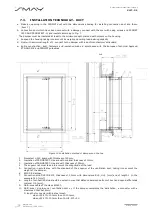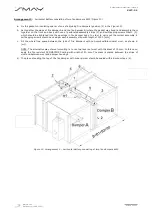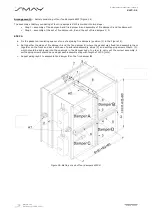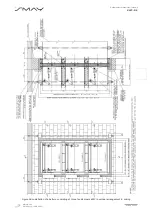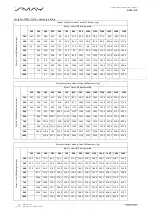
Wersja 1.00
Data edycji: 16.09.2022 r.
Strona 34 z 35
Dokumentacja techniczno-ruchowa
KWP-P-E
In order to check the proper functioning of fire damper, in particular:
a.
Check the fire damper without disconnecting the supply voltage from the actuator.
b.
The opening and closing test should be carried out by positioning the baffle
from control system („open” and
„closed” position read on the position indicator located on the actuator).
c.
Take off inspection hatch, make a visual inspection of the interior of fire damper, determine the condition of the
baffle and seal, whether there are no damage or dirt that could block the fire baffle during closing. After an
inspection put the inspection hatch back.
d.
Put the inspection hatch back. Leave the fire damper in the right work position.
e.
Make a control protocol.
Fire damper can be cleaned with a dry or damp cloth. Dirt and other pollution can be cleaned with generally available
cleaners. Do not use aggressive, caustic cleaners and sharp tools.
Table 5.Diagnostic card
Diagnostic card
No.
Symptoms of
malfunction
Causes of malfunction
How to remove malfunction
1
No signaling
opening/closing fire
damper
1. Failure to fully open the
baffle (wrong connected
ventilation duct)
2. Improperly connected wires
of limit switch
3. Damaged actuator
1. Removing the cause of blocking
baffle
2. Correct wiring
3 . Replacing the actuator with a
new one (after consulting with fire
damper`s manufacturer)
2
No actuator response
after connecting
power
1 .Damaged actuator
2. Damaged temperature
sensor
3. Locked baffle
1. Replacing the actuator with a
new one (after consulting with fire
damper`s manufacturer)
2. Replacing the temperature
sensor to a new one
3 .Removing the cause of blocking
baffle
3
No possibility of
opening the fire
damper with actuator
by key
1 .Broken mechanism in the
actuator (too rapid rotation)
2.Locked baffle
1. Replacing the actuator with a
new one (after consulting with fire
damper`s manufacturer)
2. Removing the cause of blocking
baffle


